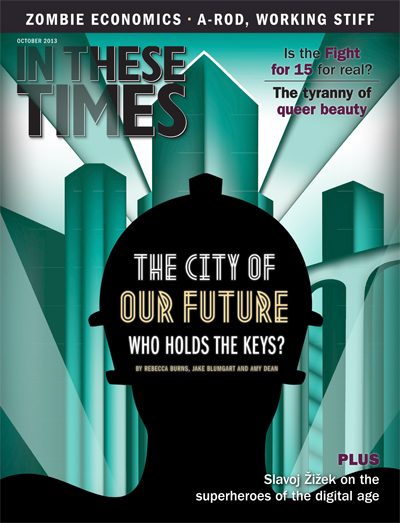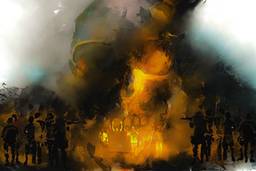Jonathan Lethem’s New Muse
A failed socialist utopia in Queens stands in for the disarray of American progressivism.
Jude Ellison Sady Doyle

I’ve lived in Astoria, Queens, since May 2003. I see Astoria as a central fact about myself. This once-uncool neighborhood in the third-least stylish of New York’s five boroughs is shaping up to be my longest personal engagement with the concept of “home.” Yes, it’s been changing. The changes can be summed up, mostly, as “gentrification,” though that doesn’t seem adequate for a neighborhood that, even 10 years ago, was regarded as a place where urban professionals moved in order to have kids. What’s changed is not the gentrification — which I am part of, and about which I cannot be self-righteous — but its aesthetic. Each new year’s wave of students is wearing more fashionable clothes than the last. We now have “vintage” clothing stores in addition to the cavernous Salvation Army on Steinway. It’s the little indie bookshops with big crowd-funding campaigns, the proliferation of places where the bartenders practice “mixology.” Queens is now the third-most stylish borough.
And now, the coup de grâce: Queens gets a novel from Jonathan Lethem. Yes, Mr. Brooklyn himself — grand mythologist of the early aughts, poet and chronicler of our smug southern rivals — has pointed his mighty trend-enhancing pen north, for his sprawling saga Dissident Gardens. The novel centers, to a large degree, on Sunnyside Gardens, a failed quasi-socialist utopia of the 1920s, created to foster urban solidarity through landscaping—An abundance of local meeting rooms would lead to civic engagement! Everyone would share the community gardens!—that has devolved, according to a 2007 New York Times article, into neighbors squabbling with each other over whether they have the right to build driveways and attic extensions in a neighborhood that’s partially classified as a historic district. (“What is this, Communism?” grouses an elderly resident quoted in the piece.) In Dissident Gardens, Sunnyside Gardens stands in, quite reasonably, for the disarray of progressive ambitions in America. For, aside from being one more step in the steady Brooklynification of my much-loved borough, the novel also attempts to be a history of 20th and 21st-century radicalism.
The damage begins in 1955, with Rose Zimmer, Sunnyside Gardens resident and devout Communist, tasked by the party with bringing the neighborhood out of false consciousness and subsequently expelled from the party for her affair with a black, married, Republican police officer. (None of Rose’s fellow progressives will clarify which of the four factors — right-wing sympathies, marital status, occupation, or race — is making them uneasy, though they seem to seize on the “cop” bit as the most likely explanation.) From Rose and her shattered ambitions, we progress to Rose’s resentful quasi-feminist hippie daughter, Miriam Zimmer, and Miriam’s husband, Tommy Gogan, an earnest folk-singer whose concept album about the urban homeless is released just on the wrong side of Dylan’s dereliction to rock. And from Miriam, we progress on to Sergius, her Occupy-adoring son, and Cicero Lookins, the gay, black, academic son of Rose’s lover, who will never forgive Rose for tearing apart his family and cannot forget (much to his own frustration) that Rose’s decision to tutor him is probably why he wound up drawn to academia in the first place.
If you promised me a Great Contemporary Novel of Queens centered around the lives and loves of radical Queens women, I’d kiss you on the mouth and prepare a space in my heart right next to where I keep all the Ellen Willis essays. But this is not that book.
Let’s start with Rose and Miriam. Lethem attempts to construct believable female psyches. (Although I wish he hadn’t given this: “She could actually feel a breeze where a trickle of her excessively fervent self had moistened her anus and inner thighs.” My self, I tell you, is not even marginally fervent about vaginal ventriloquy from grown men.) There are moments — like those depicting a young Rose, embittered by how the nominally egalitarian Party presumes to control her through her husband — when it works. But for all Lethem’s effort, Rose is a misogynist stock character, a Devouring Mother: Torrentially weepy, hideously abusive, grotesquely sexual. Lethem never misses a chance to make reference to her aging breasts.
Miriam, on the other hand, never comes together: Though Lethem name-checks the Manic Pixie Dream Girl trope — the wild, quirky, sexy bohemian girl whose narrative function is to spice up the life of a male sad sack — he’s created a prime example of it. Miriam is hip, gorgeous and full of life. Every man she meets is smitten and she gives off a super-fun but unthreatening lesbian vibe. Yet, she wants nothing more than to deploy her crotch in the service of Tommy Gogan’s artistic and political awakening. And Miriam’s eventual end is one of the harsher ways of punishing a female character for her sexuality that I’ve read in recent years.
Which is to say that, although the novel is very much about radicals, it doesn’t hold itself to any radical standards. The characters’ high ideals — we get Communism, beatniks, hippies, few and vague nods to feminism, Sandinistas, Quakers and Occupy — are used as ironic contrast to their personal messes. These people want to bring solidarity to the masses, but can’t get along with their own neighbors or children. Again, some of this works: Rose’s rage at her male colleagues’ presumptive right to control her sex life is realistic, and an indictment of the recurring failures of the Left. But it would be nice if we got to know these characters’ motivations — what they’re fighting for, and why it matters to them — rather than being continually thrown off course by Lethem’s ironic sneering language. And I am no fan of how we’re repeatedly told Cicero’s gay but never really get to know his partners.
But there are things to enjoy in Dissident Gardens. There’s Lethem’s deep engagement with New York — he did, he’s said, much more research for this novel than his others — and the way he weaves fragments of the city into myth, the way that Sunnyside Gardens and the building of Shea Stadium and the sharp curve of the train at Queensboro Plaza are all given a place in the characters’ lives and reflect their own ambitions. That’s why it was so tempting to be snide about him in the days of unquestioned Brooklyn Domination: It was a place, sure, but it was a mythologized and overexposed place, and we were sick of hearing about it.
Now, well: Moving to Queens isn’t exactly a favor to residents of the dowdier borough, and anyway the novel spends a fair amount of time in the over-mythologized grounds of Greenwich Village. But even so, Lethem knows what it means to be rooted somewhere, to have your narrative bound to and shaped by its history. He knows what it means to have a concept of home.
Jude Ellison Sady Doyle is an In These Times contributing writer. They are the author of Trainwreck: The Women We Love to Hate, Mock, and Fear… and Why (Melville House, 2016) and was the founder of the blog Tiger Beatdown. You can follow them on Twitter at @sadydoyle.









